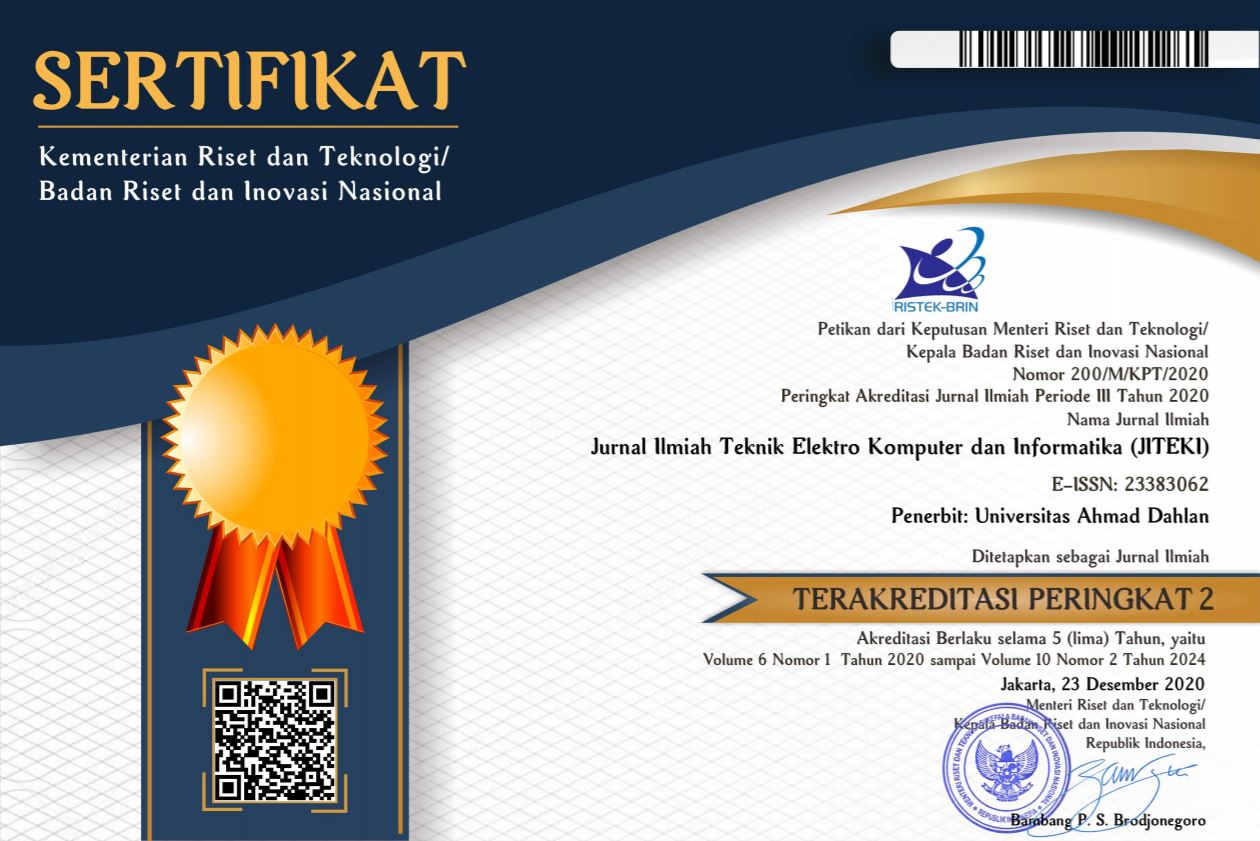Sentiment Analysis Using Maximum Entropy on Application Reviews (Study Case: Shopee on Google Play)
DOI:
https://doi.org/10.26555/jiteki.v5i1.13087Keywords:
Shopee, Google Play, Sentiment Analysis, Maximum Entropy, Word AssociationAbstract
Shopee was one of the e-commerce application that could found on Google Play. The amount of Shopee application reviews on Google Play continues to grow over time. These make the company trying to get the overall information from all reviews because it would take a long time to read each of the reviews on Google Play. Therefore analysis was used using text mining. One part of text mining was sentiment analysis that applied the maximum entropy method to classification. Based on the results of the analysis found an accuracy of 97.32%. By using the maximum entropy method it could be concluded that word association obtained related to “applicationâ€, “promoâ€, “satisfyâ€, and “discount†for positive sentiment. Meanwhile for negative sentiment, the reviewers of Shopee application on Google Play were related to “problematicâ€, “loginâ€, “oldâ€, “verificationâ€, and “expensiveâ€. The results of this research in Indonesian.References
S. Anwar Hridoy, M. Ekram, M. Islam et al., “Localized Twitter Opinion Mining using Sentiment Analysis,†Decision Analytic, 2015, available at: Google Scholar.
N. Mehra, S. Khandelwal, P. Patel, “Sentiment Identification using Maximum Entropy Analysis of Movie Reviews,†International Journal of Computer Applications, 2016, available at: Google Scholar.
B. Wagh, J. Shinde, P. Kale, “A Twitter Sentiment Analysis using NLTK and Machine Learning Techniques,†International Journal of Emerging Research in Management and Technology., vol. 6, pp. 37, 2018, available at: Google Scholar.
W. Medhat, A. Hassan, and H.Korashy, “Sentiment Analysis and Applications: A Survey,†AIN Shams Engineering Journal., vol. 5, pp. 1093-1113, 2014, doi: 10.1016/j.asej.2014.04.011.
L. Zheng, H.Wang, and S.Gao, “Sentimental Feature Selection for Sentiment Analysis pf Chinese Online Reviews,†International Journal of Machine Learning and Cybernetics., vol.9, pp. 75-84, 2018, available at: Google Scholar.
H. Htet, and Y. Myint, “Social Media (Twitter) Data Analysis using Maximum Entropy Classifier on Big Data Processing Framework (Case Study : Analysis of Health Condition, Education Status, State of Business),†Journal of Pharmacognosy and Phytochemistry., vol. 7, pp. 695-700, 2018, available at: Google.
A. Gupte, S. Joshi, P. Gadhul, and A. Kadam, “Comparative Study of Classification Algorithm used in Sentiment Analysis,†International Journal of Computer Science and Information Technologies., vol. 5, pp. 6261-6264, 2014, available at: Google Scholar
D. Patel, S. Saxena, and T.Verma, “Sentiment Analysis using Maximum Entropy Algorithm in Big Data,†International Journal of Innovative Research in Science, Engineering and Technology., vol. 5, pp. 8356-8361, 2016, available at: Google Scholar.
P. Milev, “Conceptual Approach for Development of Web Scraping Application for Tracking Information,†Economic Articles., issue 3, pp. 475-485, 2017, available at: Google Scholar.
T. Agrawal, and A.Singhal, “An Efficient Knowledge-Based Text Pre-processing Approach for Twitter and Google+â€, Springer., pp. 379-389, ISBN 978-981-13-9942, 2019, available at: Google Scholar.
A. B. Panwar, M. A. Jawali, and D. N. Kyatanavar, “Fundamentals of Sentiment Analysis: Concepts and Methodology,†Sentiment Analysis and Ontology Engineering., pp. 25-48, ISBN 978-3-319-30317-8, 2016, available at: Google Scholar.
X. Xie, S.Ge, F.Hu, M.Xie, A and N. Jiang, “An Improved Algorithm for Sentiment Analysis Based on Maximum Entropy,†Soft Computing, vol.23, pp. 599-611, 2017, available at: Google Scholar.
Z. Zhao, T. Liu, B. Li, and X. Bu, “Correction to: Guiding the Training of Distributed text Representation With Supervised Weighting Scheme for Sentiment Analysis.†Data Science and Engineering, vol. 2, Issue. 4, 2017, doi: 10.1007/s41019-017-0040-6.
C. C. Aggrawal, Data Mining: The Textbook, Swiss: Springer International Publishing Switzerland, 2015, available at: Google.
S. Suthaharan, “Machine Learning Models and Algorithms for Big Data Classification: Thinking with Examples for Effective Learning,†Springer., pp.10, 2015, available at: Google Scholar.
Downloads
Published
How to Cite
Issue
Section
License
Authors who publish with JITEKI agree to the following terms:
- Authors retain copyright and grant the journal the right of first publication with the work simultaneously licensed under a Creative Commons Attribution License (CC BY-SA 4.0) that allows others to share the work with an acknowledgment of the work's authorship and initial publication in this journal.
- Authors are able to enter into separate, additional contractual arrangements for the non-exclusive distribution of the journal's published version of the work (e.g., post it to an institutional repository or publish it in a book), with an acknowledgment of its initial publication in this journal.
- Authors are permitted and encouraged to post their work online (e.g., in institutional repositories or on their website) prior to and during the submission process, as it can lead to productive exchanges, as well as earlier and greater citation of published work.

This work is licensed under a Creative Commons Attribution 4.0 International License

